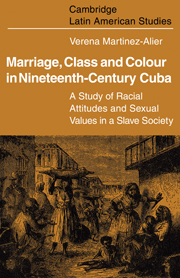 Marriage, Class and Colour in Nineteenth Century Cuba
Marriage, Class and Colour in Nineteenth Century Cuba Published online by Cambridge University Press: 09 October 2009
Social class endogamy was the officially and socially preferred form of marriage both among whites and among coloured people in nineteenth-century Cuba. Most marriages conformed to this pattern. When a young couple, however, decided to disregard established norms on choice of spouse they could do two things to get away with it. They could either appeal to the authorities for a supplementary marriage licence overruling parental dissent, or, more drastically, they could elope. Once the families and society had been presented with this fait accompli parents would presumably find it much harder to uphold their initial objections. Such practice was not uncommon in colonial America nor in nineteenth-century Cuba.
Already in 1780 we find the Audiencia de Chile complaining about ‘the excesses that have been noted there, and that are subject to punishment, of those who remove daughters from the authority of their fathers and take them to the open fields and to a deserted place and keep them there for a few days in an attempt to marry them under the pretence that the parents are against it’. And Cuban popular literature contains repeated allusions to elopement. In El Perro Huevero, a contemporary satire, Mónica, the daughter of Matías, elopes with Mamerto el indiano and later promises to marry him. When the play was staged in Havana shortly after the onset of the Ten Years War the Voluntarios caused a riot: for it was generally assumed that Matías, a cock-fighter and gambler, was no other than the Spanish government, that Mónica was the island of Cuba who endeavoured to free herself from the colonial yoke, and Mamerto represented the rebels.
To save this book to your Kindle, first ensure [email protected] is added to your Approved Personal Document E-mail List under your Personal Document Settings on the Manage Your Content and Devices page of your Amazon account. Then enter the ‘name’ part of your Kindle email address below. Find out more about saving to your Kindle.
Note you can select to save to either the @free.kindle.com or @kindle.com variations. ‘@free.kindle.com’ emails are free but can only be saved to your device when it is connected to wi-fi. ‘@kindle.com’ emails can be delivered even when you are not connected to wi-fi, but note that service fees apply.
Find out more about the Kindle Personal Document Service.
To save content items to your account, please confirm that you agree to abide by our usage policies. If this is the first time you use this feature, you will be asked to authorise Cambridge Core to connect with your account. Find out more about saving content to Dropbox.
To save content items to your account, please confirm that you agree to abide by our usage policies. If this is the first time you use this feature, you will be asked to authorise Cambridge Core to connect with your account. Find out more about saving content to Google Drive.